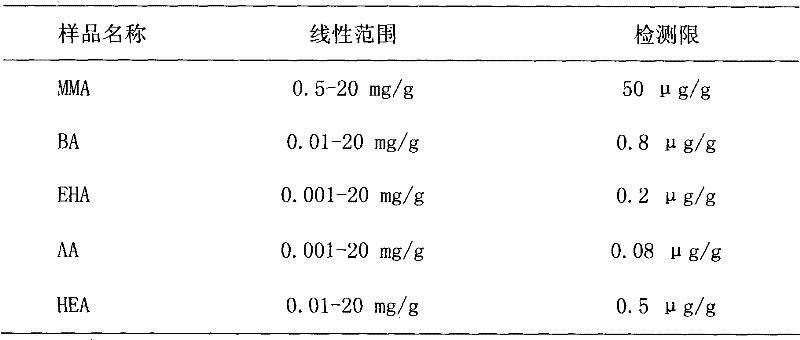Method for testing contents of residual monomers in acrylate pressure sensitive adhesive by virtue of gas chromatography
A gas chromatography and acrylate technology, which is used in the field of gas chromatography to test the amount of various residual monomers in acrylate pressure-sensitive adhesives, can solve the problems of non-reported pressure-sensitive adhesives, etc., and achieve high sensitivity and operation Convenient, Highly Selective Effects
- Summary
- Abstract
- Description
- Claims
- Application Information
AI Technical Summary
Problems solved by technology
Method used
Image
Examples
Embodiment Construction
[0013] The reactive monomers of acrylate pressure-sensitive adhesives are mainly acrylates, among which isooctyl acrylate (EHA), butyl acrylate (BA), acrylic acid (AA), methyl methacrylate (MMA), acrylic acid Monomers such as hydroxyethyl ester (HEA). In this method, these monomers are successfully separated by gas chromatography, and the content of each residual monomer is determined.
[0014] Equipment: gas chromatograph with programmable temperature rise, equipped with FID hydrogen flame detector; high-purity hydrogen generator and low-noise air pump; ultra-pure nitrogen as carrier gas; high-purity hydrogen and dry air as auxiliary gas.
[0015] Chromatographic analysis conditions:
[0016] Chromatographic column: TM-FFAP 30m×0.32m×0.5μm; carrier gas flow rate: 10mL / min; split mode: splitless; H2: 40mL / min; air: 400mL / min; : 275°C; the column temperature adopts a temperature programming method: 100°C constant temperature for 5min-heating at a speed of 10°C / min to 200°C-co...
PUM
 Login to View More
Login to View More Abstract
Description
Claims
Application Information
 Login to View More
Login to View More - R&D
- Intellectual Property
- Life Sciences
- Materials
- Tech Scout
- Unparalleled Data Quality
- Higher Quality Content
- 60% Fewer Hallucinations
Browse by: Latest US Patents, China's latest patents, Technical Efficacy Thesaurus, Application Domain, Technology Topic, Popular Technical Reports.
© 2025 PatSnap. All rights reserved.Legal|Privacy policy|Modern Slavery Act Transparency Statement|Sitemap|About US| Contact US: help@patsnap.com



